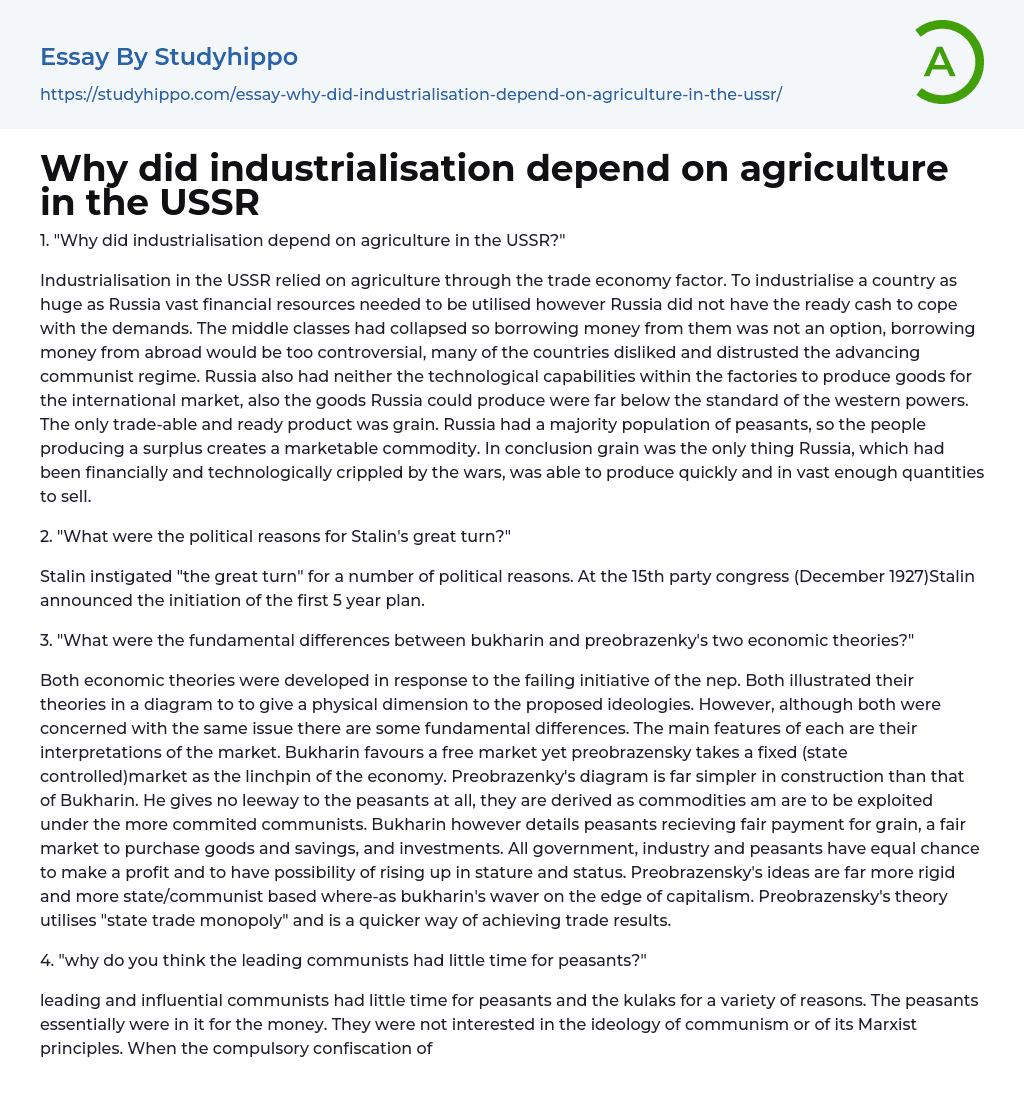

Why did industrialisation depend on agriculture in the USSR Essay Example
Industrialisation in the USSR was dependent on agriculture due to various factors. The country needed significant financial resources to carry out the process of industrialisation, but lacked the necessary funds. The collapse of the middle classes meant that borrowing money from them was not an option. Additionally, borrowing money from abroad would have been controversial as many countries distrusted the advancing communist regime in Russia. Furthermore, Russia lacked the technological capabilities in its factories to produce goods of international standard. The only tradeable and readily available product was grain, as the majority of the population were peasants who produced a surplus of this commodity. Thus, despite being financially and technologically crippled by wars, Russia could quickly produce and sell large quantities of grain, making it their main agricultural reliance for industrialisation.
2. "What were the political factors be
...hind Stalin's decision to implement the great turn?"
Stalin implemented "the great turn" in response to several political considerations. At the 15th party congress (December 1927), he publicly declared the beginning of the first five-year plan.
3. "What were the fundamental differences between Bukharin and Preobrazenky's two economic theories?"
Both economic theories were developed in response to the failing initiative of the NEP. Both illustrated their theories in a diagram to give a physical dimension to the proposed ideologies. However, although both were concerned with the same issue, there are some fundamental differences.
The main features of each theory lie in their interpretations of the market. Bukharin advocates for a free market, while Preobrazensky favors a fixed (state-controlled) market as the linchpin of the economy. Preobrazensky's diagram is much simpler in construction compared to that of Bukharin. He offers no leeway t
the peasants, treating them as commodities to be exploited under the more committed communists.
On the other hand, Bukharin's theory details peasants receiving fair payment for grain, a fair market for purchasing goods, and opportunities for savings and investments. In his theory, all sectors of the government, industry, and peasantry have an equal chance to make a profit and rise in stature and status.
Preobrazensky's ideas are more rigid and state/communist-based, while Bukharin's hover on the edge of capitalism. Preobrazensky's theory employs a "state trade monopoly" and promises faster trade results.
"Why do you think the leading communists had little time for peasants?"
There were various reasons why the leading and influential communists showed little interest in peasants and kulaks. Firstly, these peasants were primarily motivated by economic gain rather than the ideology or principles of communism and Marxism. When the government implemented compulsory confiscation of surplus grain during war communism, the kulaks were accused of intentionally hoarding grain. As a result, they became indifferent and only grew enough grain to sustain themselves, their families, and for future planting.
This situation had a negative impact on urban workers, as the price of bread was disproportionately high compared to their average wages. This gave rise to the scissors crisis. Due to their lack of education and rural background, the peasants had nothing significant to contribute to the socialist order. Karl Marx himself stated that "socialism can only exist in a state where the majority are urban workers."
Since the peasants were below the urban workers in social status, as long as they fulfilled their grain quota for the state and remained out of the communist leaders' way, they had little interaction with
them.
5. "What benefits would the Great Turn bring to the Soviet Union?"
The implementation of Stalin's "Great Turn" and the introduction of the 5-year plans (5YPs) had a significant impact on the economic and social aspects of the country. The failure of the New Economic Policy (NEP) resulted in high unemployment rates, limited productivity in factories and industries, and expensive food prices in comparison to incomes. Prior to the revolution, Russia exported 12 million tonnes of grain in a normal year, but under the NEP, it never exceeded 3 million tonnes. With Stalin's new economic policy, inspired by Preobrazenky's theory, rapid industrialization occurred alongside increased trade.
State control would be crucial for significantly improving productivity. Stalin's collectivisation plans would also greatly benefit many Russians. All peasants would receive support, housing, food, and stability. All workers would have a job and a state-owned house. The government would gain substantial profits from the issue of state control.
- Agriculture essays
- Albert einstein essays
- Animals essays
- Archaeology essays
- Bear essays
- Biology essays
- Birds essays
- Butterfly essays
- Cat essays
- Charles Darwin essays
- Chemistry essays
- Dinosaur essays
- Discovery essays
- Dolphin essays
- Elephant essays
- Eli Whitney essays
- Environmental Science essays
- Evolution essays
- Fish essays
- Genetics essays
- Horse essays
- Human Evolution essays
- Isaac Newton essays
- Journal essays
- Linguistics essays
- Lion essays
- Logic essays
- Mars essays
- Methodology essays
- Mineralogy essays
- Monkey essays
- Moon essays
- Mythology essays
- Noam Chomsky essays
- Physics essays
- Plate Tectonics essays
- Progress essays
- Reaction Rate essays
- Roman Numerals essays
- Scientific essays
- Scientific Method essays
- Scientist essays
- Seismology essays
- Space Exploration essays
- Stars essays
- Sun essays
- Thomas Edison essays
- Tiger essays
- Time Travel essays
- Universe essays



